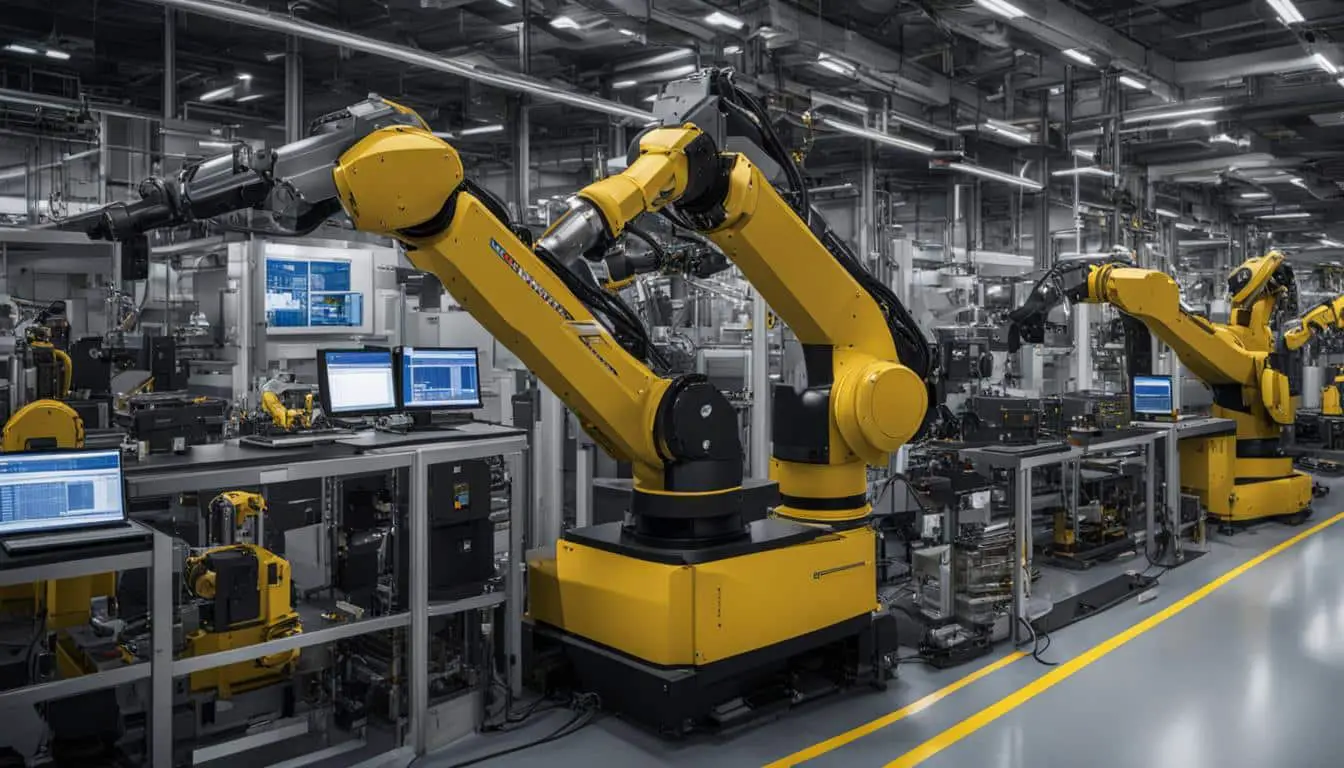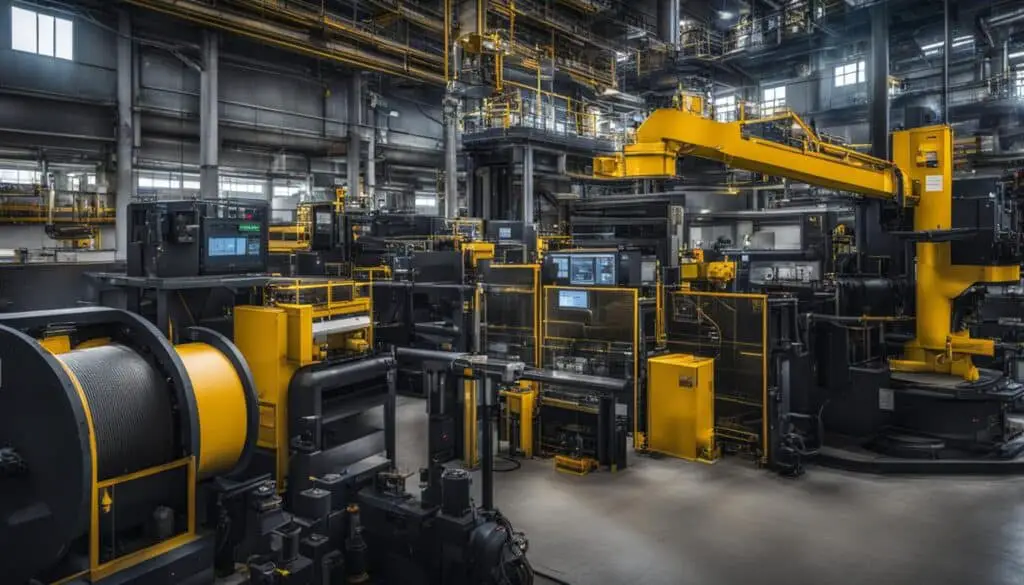
Artificial intelligence (AI) has revolutionized various industries, and now it is transforming the world of maintenance as well. With the advent of AI predictive maintenance technology, organizations can proactively address potential equipment failures before they occur, leading to improved efficiency and productivity.
AI-powered predictive maintenance utilizes advanced algorithms and machine learning technology to analyze vast volumes of data and provide valuable insights. By harnessing the power of AI, organizations can optimize their maintenance operations, minimize downtime, and maximize asset utilization.
This innovative technology not only saves on labor and material costs but also enhances safety, quality control, and environmental management. By empowering the workforce with AI-driven maintenance solutions, organizations can revolutionize their physical asset management and achieve operational excellence.
Key Takeaways:
- AI-powered predictive maintenance uses AI and machine learning technology to anticipate and address potential equipment failures.
- This technology enables organizations to optimize maintenance operations, minimize downtime, and save on costs.
- AI-driven maintenance solutions improve safety, quality control, and environmental management.
- The integration of AI in predictive maintenance empowers the workforce and revolutionizes asset management.
- By embracing AI-powered predictive maintenance, organizations can drive operational excellence and gain a competitive edge.
The Value of AI in Predictive Maintenance
Implementing AI-powered predictive maintenance systems brings significant value to organizations. By utilizing intelligent predictive maintenance tools and machine learning algorithms, companies can optimize their maintenance operations and achieve cost savings. Traditional maintenance approaches, such as scheduled maintenance checks and condition-based maintenance, may not always be sufficient to ensure asset reliability in today’s fast-paced and complex manufacturing and logistics environments. AI-driven maintenance strategies offer a multi-dimensional value by preventing cascading impacts, elevating ROI through extended machine life, empowering the workforce to focus on proactive maintenance, supporting procurement planning, improving safety, enhancing quality control, and managing environmental impact.
With the help of AI and machine learning, organizations can analyze vast amounts of data from sensors, historical maintenance and repair records, production data, and employee reports to gain a comprehensive understanding of asset performance and predict potential failures. By prioritizing maintenance recommendations and automating processes, AI-driven predictive maintenance systems optimize resource allocation and improve overall operational efficiency.
To highlight the value of AI in predictive maintenance, here are some key benefits:
- Enhanced Efficiency: AI-powered systems can analyze large volumes of data in real-time, enabling organizations to proactively address maintenance issues and minimize downtime.
- Cost Savings: By predicting and preventing asset failures, organizations can save on labor and material costs associated with unscheduled maintenance and repairs.
- Improved Safety: AI-driven maintenance strategies help identify potential safety risks and enable organizations to take proactive measures to mitigate them.
- Quality Control: Advanced analytics and machine learning algorithms can detect patterns and anomalies in data, ensuring consistent product quality and reducing defects.
- Environmental Impact: AI-powered predictive maintenance systems enable organizations to optimize energy consumption and reduce their environmental footprint.
Overall, the value of AI in predictive maintenance lies in its ability to leverage data analytics, IoT technologies, and advanced algorithms to provide valuable insights and recommendations. By embracing AI-driven maintenance strategies, organizations can optimize their operations, reduce costs, improve safety, enhance quality control, and minimize their environmental impact.
| Key Value of AI in Predictive Maintenance | Description |
|---|---|
| Enhanced Efficiency | By analyzing large amounts of data, AI-powered systems can predict and prevent asset failures, minimizing downtime and maximizing productivity. |
| Cost Savings | AI-driven maintenance strategies help organizations save on labor and material costs associated with unscheduled maintenance and repairs. |
| Improved Safety | AI-powered systems can identify potential safety risks and enable organizations to take proactive measures to mitigate them. |
| Quality Control | Advanced analytics and machine learning algorithms can detect patterns and anomalies in data, ensuring consistent product quality and reducing defects. |
| Environmental Impact | AI-powered predictive maintenance systems enable organizations to optimize energy consumption and reduce their environmental footprint. |
Implementing AI in Predictive Maintenance
Implementing artificial intelligence (AI) in predictive maintenance is crucial for organizations looking to optimize their maintenance operations and achieve cost savings. By integrating AI technologies, such as IoT predictive maintenance and advanced analytics, organizations can gather valuable insights to proactively manage their assets and improve overall operational efficiency.
One important aspect of implementing AI in predictive maintenance is leveraging IoT technologies. By incorporating sensors into key components and collecting data from various sources, such as procurement and ERP systems, historical maintenance records, and production data, organizations can create a comprehensive data ecosystem for predictive maintenance.
The Role of Advanced Analytics
Advanced analytics plays a pivotal role in AI-driven predictive maintenance. By applying machine learning algorithms to analyze vast amounts of data, organizations can gain a deeper understanding of asset performance and predict potential failures. This enables them to prioritize maintenance tasks, optimize resource allocation, and improve workforce productivity. Advanced analytics also supports data-driven decision making, allowing organizations to make proactive maintenance recommendations based on historical data and real-time insights.
Collaborating with experienced partners, like Deloitte, can expedite the implementation process and ensure successful adoption of AI-driven predictive maintenance systems. These partners can help integrate data collection, inference engines, and action engines, as well as provide the necessary change management, documentation, and training. With the right expertise and resources, organizations can scale AI-powered predictive maintenance solutions from pilot programs to enterprise-wide implementation.
| Benefits of Implementing AI in Predictive Maintenance |
|---|
| Optimized maintenance operations |
| Reduced downtime |
| Extended equipment life |
| Improved overall productivity |
Implementing AI in predictive maintenance offers numerous benefits, including optimized maintenance operations, reduced downtime, extended equipment life, and improved overall productivity. By leveraging the power of AI and advanced analytics, organizations can proactively address potential equipment failures and drive operational excellence.

Conclusion
The integration of AI in the predictive maintenance industry has ushered in a new era of smart maintenance solutions. By leveraging advanced analytics and machine learning algorithms, organizations can proactively address potential equipment failures before they occur. The use of AI and predictive maintenance technologies allows businesses to optimize their maintenance operations, reduce downtime, and extend the lifespan of their equipment.
AI-powered systems provide valuable insights and recommendations by analyzing vast amounts of data from various sources. By harnessing the power of data analytics and IoT technologies, organizations can make informed decisions regarding maintenance tasks and resource allocation. This not only leads to cost savings but also improves safety, enhances quality control, and reduces environmental impact.
Successfully implementing AI in predictive maintenance requires establishing reliable data sources and working with experienced partners. By collaborating with knowledgeable professionals, organizations can ensure seamless integration, adoption, and scalability of AI-driven maintenance strategies. As the AI Predictive Maintenance Industry continues to evolve, embracing these technological advancements will give organizations a competitive edge in driving operational excellence.
FAQ
What is predictive maintenance?
Predictive maintenance is an innovative approach that utilizes AI and machine learning technology to anticipate and address potential equipment failures before they occur.
How does AI-powered predictive maintenance work?
AI-powered predictive maintenance systems analyze large volumes of data to provide valuable insights, enhance efficiency, predict equipment failures, and boost productivity in various industries.
What are the benefits of implementing AI in predictive maintenance?
Implementing AI-powered predictive maintenance systems brings significant value by optimizing maintenance operations, achieving cost savings, improving safety, enhancing quality control, and managing environmental impact.
What data sources are needed for AI predictive maintenance?
Organizations need to incorporate additional data sources, such as sensors, procurement and ERP systems, historical maintenance records, and production data, to create a comprehensive data ecosystem for predictive maintenance.
How can organizations integrate AI and IoT technologies for predictive maintenance?
By integrating sensors into key components and leveraging IoT technologies, organizations can collect data from various sources and utilize AI-enabled signal processing and advanced analytics to generate maintenance recommendations.
How can organizations successfully implement AI in predictive maintenance?
Organizations can establish reliable data sources, leverage machine learning algorithms, and collaborate with experienced partners to ensure seamless integration and adoption of AI-driven predictive maintenance systems.
What are the advantages of AI in predictive maintenance?
The advantages of AI in predictive maintenance include reduced downtime, extended equipment life, improved overall productivity, cost savings, improved safety, enhanced quality control, and reduced environmental impact.
How can AI-driven predictive maintenance systems be customized to specific organizational needs?
AI-driven predictive maintenance systems can be customized to the specific needs of each organization and can be scaled from pilot programs to enterprise-wide implementation with the help of experienced partners.
What is the potential impact of AI in the predictive maintenance industry?
The integration of AI in predictive maintenance revolutionizes the industry by enabling organizations to proactively address potential equipment failures, optimize maintenance operations, reduce downtime, and improve overall productivity.
How can organizations gain a competitive edge with AI predictive maintenance?
Organizations that embrace AI predictive maintenance have the opportunity to gain a competitive edge and drive operational excellence by leveraging data analytics, IoT technologies, and advanced algorithms for optimized maintenance operations.
Source Links
- https://www2.deloitte.com/us/en/pages/consulting/articles/using-ai-in-predictive-maintenance.html
- https://www.advancedtech.com/blog/the-role-of-ai-in-predictive-maintenance/
- https://www.datarobot.com/wiki/predictive-maintenance/








